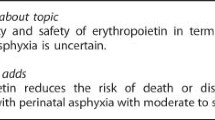Abstract
Objective: Glutamate plays a critical role in the hypoxic ischaemic neuronal death. Two mechanisms of glutamate-induced neuronal death have been identified. One is rapid cell death that occurs in minutes and the second is delayed cell death that occurs over hours and is initiated principally by the activation of the N-methyl D-Aspactate (NMDA) receptor. Magnesium (Mg) is an NMDA receptor blocker. Systemic administration of Mg after a simulated hypoxic ischaemic insult has been shown to limit neuronal injury in several animal models. However, before embarking on to the use of Mg for neuronal protection in the human neonate, it is important to study the safety and side effects of Mg administration.Methods: Forty terms, appropriate for gestational age babies with severe birth asphyxia (1 min Apgar score <3 and 5min Apgar score <6), were randomly assigned to either the study group or the control group. Infants in both groups were treated as per unit protocol except that babies in the study group received intravenous injection of magnesium sulphate 250 mg/kg within half an hour of birth, and subsequently 125 mg/kg at 24 and 48 hours of life.Results: The mean cord blood serum Mg levels were 0.78 (±0.047) mmol/L in the control group and 0.779 (±0.045) mmol/L in the study group. The serum Mg levels at 3, 6, 12, 24, 48 and 72 hours of life were 1.87 (±0.6), 1.65(±0.059), 1.468 (±0.91), 1.881 (±0.053), 1.916 (±0.053) and 1.493 (±0.084) mmol/L respectively in the study group. All these values were significantly higher than those obtained in the control group (p<0.001). No significant alterations in heart rate, respiratory rate, oxygen saturation and mean arterial pressure were seen, following magnesium infusion with either 250 mg/kg or 125 mg/kg dose. The serum Mg levels in the study group ranged between 1.493 (±0.084) and 1.916 (±0.053) mmol/L, which are considered to be in the neuroprotective range.Conclusion: Injection MgSO4 administered in a dose of 250 mg/kg and 125 mg/kg as an intravenous infusion is safe, and the Mg levels obtained are in the range considered to be neuropropective.
Similar content being viewed by others
References
Choi DW, Harley DM. Calcium and Glutamate induced cortical neuronal death. In Waxman SG, ed.Molecular and cellular approaches to the treatment of Neurological Disease. New York; sRaven Press, 1993; 122–129.
Barks JDE, Silverstein FS. Excitatory amino acids contribute to the pathogenesis of perinatal hypoxic ischemic brain injury.Brain Pathol 1992; 2: 235–243.
Nowak L, Bregestovski P, Ascher P, Herbert A, Prochiantz A. Magnesium gates glutamate activated channels in mouse central neurons.Nature 1984; 307: 462–465.
Dunne JJ, Milligan JE, Thomas BW. The effects of MgSO4 on anoxia and resuscitation in the neonate.Am J Obstet Gynae 1971; 109: 369–374.
McIntosh TK, Vink R, Yamakami I, Faden AI. Magnesium neuroprotects against neurological deficit after brain injury.Brain Res 1989; 482: 252–260.
Robertson CS, Foltz R, Grossman RG, Goodman JC. Protection against experimental ischaemic spinal cord injury.J Neurosurg 1986; 64: 633–642.
Rothman S. Synaptic release of excitatory amino acid neurotransmitter mediates anoxic neuronal death.J Neurosci 1984; 4: 1884–1891.
Hoffman DJ, Marro PJ, Mc Gowan JE, Mishra OP, Papadopoulos MD. Protective effects of MgSo4 Infusion on NMDA receptor binding characteristics during cerebral cortical hypoxia in newborn piglet.Brain Res 1994; 644: 144–149.
Nakajima W, Ishida A, Takada G. Magnesium attenuates a striatal dopamine increase, induced by anoxia in neonatal rat brain: an in vivo micro dialysis study.Brain Res 1997; 41: 809–814.
Thordstein M, Bagenholm R, Thringer K, Kjillmer I. Scavengers of free oxygen radicals in combination with magnesium ameliorate perinatal hypoxic ischemic brain damage in the rat.Brain Res 1993; 34: 23–26.
Levene MI, Evans DJ, Mason S, Brown J. An international Network for evaluating neuroprotective therapy after severe birth asphyxia.Seminars in Perinatol 1999; 23; 223–233.
Gathwala G. Neuronal protection with Magnesium.Indian J Pediatr 2001; 68: 417–419.
Levene M, Blennow M, Whitelaw A, Hanko E, Fellman V, Hartley R. Acute effects of two different doses of magnesium sulphate in infants with birth asphyxia.Arch Dis Child 1995; 73: F174-F177.
Ballard JL. New Ballard score expanded to include extremely premature infants.J Pediatr 1991; 119: 417–423.
Lubchenco L, Hansman C, Boyd E, Intrauterine growth in length and head circumference as estimated from live births at gestational ages from 26 to 42 weeks.Pediatr 1996; 37: 403–408.
Sunderman WF, Carrol JE. Measurements of serum calcium and magnesium by atomic absorption spectrophotometer.Am J Clin Path 1965; 43: 302–308.
Bajpai PC, Sugden D, Ramos A, Stern I. Serum magnesium levels in the newborn and older child. Arch.Dis Child 1966; 41: 424–427.
Harrison V, Peat G. Red blood cell magnesium and Hypoxic ischaemic encephalopthy.Early Hum. Dev 1997; 47: 286–296.
Ilves P Kiisk M, Soopold T, Talvik T. Serum total magnesium and ionized calcium concentrations in asphyxiated newborn infants with hypoxic ischaemic encephalopathy.Acta Pedatr 2000; 89: 680–685
Yousef K, Abu Osba, Gala O, Manosral K, Regal A. Treatment of severe persistent pulmonary hypertension of the newborn with MgSO4.Arch Dis Child 1992; 67: 31–35.
Opelt WW, MacIntyre I and Rall DP. Magnesium exchange between blood and cerebrospinal fluid.Am J Physiol 1963; 205: 959–962.
Roth SC, Edwards AD, Cady EB, Delpy DT, Wyatt JS, Azzopardi D Relation between cerebral oxidative metabolism following birth asphyxia and neurodevelopment out come and brain growth at one year.Dev Med Child Neurol 1992; 34: 285–295.
Randall RE, Cohen MD, Spray CC, Rossmeisl EC. Hypermagnesaemia in renal failure—etiology and toxic manifestation.Ann Internal Med 1964; 61: 73–79.
Cropp GJA. Reduction of hypoxic pulmonary vasoconstriction by magnesium chloride.J Appl Physiol 1968; 24: 755–760.
Author information
Authors and Affiliations
Corresponding author
Rights and permissions
About this article
Cite this article
Gathwala, G., Khera, A. & Singh, I. Magnesium therapy in birth asphyxia. Indian J Pediatr 73, 209–212 (2006). https://doi.org/10.1007/BF02825482
Issue Date:
DOI: https://doi.org/10.1007/BF02825482




